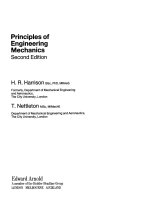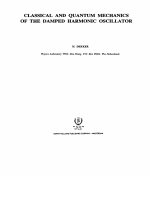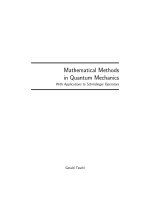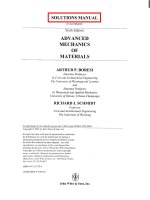- Trang chủ >>
- Khoa Học Tự Nhiên >>
- Vật lý
Quantum mechanics 6th edition
Bạn đang xem bản rút gọn của tài liệu. Xem và tải ngay bản đầy đủ của tài liệu tại đây (6.9 MB, 437 trang )
QUANTUM MECHANICS
SIXTH
EDITION
rae • napoltano
PHYSICS
“This is a very versatile textbook, which could be used in a variety of courses ranging from an
‘honors’ introductory course to a challenging undergraduate upper-class course. … The book is
divided into parts, making it easy for an instructor to choose the relevant material based on the
level of the class.”
—Robert Pelcovits, Professor of Physics, Brown University
“This book by Rae and Napolitano distinguishes itself with a unique approach by including more
material on practical applications of the theoretical concepts … a great choice of textbook
for upper-class undergraduate students in physics or students entering graduate studies in
engineering schools.”
—Professor Chunhui Chen, Iowa State University
“This text provides an updated treatment of quantum mechanics, suitable for the standard seniorlevel undergraduate course at U.S. colleges and universities.”
—Dr. Pete Markowitz, Professor, Department of Physics, Florida International University
K24456
an informa business
6000 Broken Sound Parkway, NW
Suite 300, Boca Raton, FL 33487
711 Third Avenue
New York, NY 10017
2 Park Square, Milton Park
Abingdon, Oxon OX14 4RN, UK
ISBN: 978-1-4822-9918-2
90000
9 78 1 482 299 1 82
w w w. c rc p r e s s . c o m
sixth edition
Quantum Mechanics, Sixth Edition builds on its highly praised predecessors to make the text
even more accessible to a wider audience. This sixth edition contains three new chapters that review
prerequisite physics and mathematics, laying out the notation, formalism, and physical basis necessary
for the rest of the book. Along with more problems, this edition also presents short descriptions of
numerous applications relevant to the physics discussed, offering a brief look at what quantum
mechanics has made possible industrially and scientifically.
SIXTH EDITION
QUANTUM MECHANICS
“The new sixth edition of this well-known textbook should be thought of as one of the best
options available for undergraduate quantum mechanics courses, among a very large class of
introductory books. … Detailed worked examples and asides on associated applications of the
principles discussed enhance the educational aspects of this book.”
—Aaron Lindenberg, Associate Professor, Department of Materials Science and
Engineering/Photon Science, Stanford University/SLAC National Accelerator Laboratory
QUANTUM
MECHANICS
Alastair I. M. Rae
Jim Napolitano
www.pdfgrip.com
QUANTUM
MECHANICS
SIXTH EDITION
www.pdfgrip.com
www.pdfgrip.com
QUANTUM
MECHANICS
SIXTH EDITION
Alastair I. M. Rae
University of Birmingham, U.K.
Jim Napolitano
Temple University, U.S.A.
Boca Raton London New York
CRC Press is an imprint of the
Taylor & Francis Group, an informa business
www.pdfgrip.com
CRC Press
Taylor & Francis Group
6000 Broken Sound Parkway NW, Suite 300
Boca Raton, FL 33487-2742
© 2016 by Taylor & Francis Group, LLC
CRC Press is an imprint of Taylor & Francis Group, an Informa business
No claim to original U.S. Government works
Version Date: 20151105
International Standard Book Number-13: 978-1-4822-9921-2 (eBook - PDF)
This book contains information obtained from authentic and highly regarded sources. Reasonable
efforts have been made to publish reliable data and information, but the author and publisher cannot
assume responsibility for the validity of all materials or the consequences of their use. The authors and
publishers have attempted to trace the copyright holders of all material reproduced in this publication
and apologize to copyright holders if permission to publish in this form has not been obtained. If any
copyright material has not been acknowledged please write and let us know so we may rectify in any
future reprint.
Except as permitted under U.S. Copyright Law, no part of this book may be reprinted, reproduced,
transmitted, or utilized in any form by any electronic, mechanical, or other means, now known or
hereafter invented, including photocopying, microfilming, and recording, or in any information storage or retrieval system, without written permission from the publishers.
For permission to photocopy or use material electronically from this work, please access www.copyright.com ( or contact the Copyright Clearance Center, Inc. (CCC), 222
Rosewood Drive, Danvers, MA 01923, 978-750-8400. CCC is a not-for-profit organization that provides licenses and registration for a variety of users. For organizations that have been granted a photocopy license by the CCC, a separate system of payment has been arranged.
Trademark Notice: Product or corporate names may be trademarks or registered trademarks, and are
used only for identification and explanation without intent to infringe.
Visit the Taylor & Francis Web site at
and the CRC Press Web site at
www.pdfgrip.com
To Angus and Gavin
To Julia
www.pdfgrip.com
www.pdfgrip.com
Contents
PART I
Waves, Electromagnetism, and the Limits of Classical
Physics
CHAPTER 1 The Physics and Mathematics of Waves
1.1
1.2
1.3
1.4
1.5
A REVIEW OF SIMPLE HARMONIC MOTION
THE STRETCHED STRING EQUATION OF MOTION
STANDING WAVES, AND FOURIER SERIES
THE FOURIER TRANSFORM
PROBLEMS
CHAPTER 2 Maxwell’s Equations and Electromagnetic
Waves
2.1
2.2
2.3
2.4
2.5
2.6
MAXWELL’S EQUATIONS AS INTEGRALS
SURFACE THEOREMS IN VECTOR CALCULUS
MAXWELL’S EQUATIONS AS DERIVATIVES
ELECTROMAGNETIC WAVES
ELECTROMAGNETIC RADIATION
PROBLEMS
CHAPTER 3 Particle Mechanics, Relativity, and Photons
3.1
3.2
3.3
3.4
NEWTON, MAXWELL, AND EINSTEIN
SPACETIME IN SPECIAL RELATIVITY
VELOCITY, MOMENTUM, AND ENERGY
PROBLEMS
CHAPTER 4 The Early Development of Quantum
Mechanics
4.1
4.2
THE PHOTOELECTRIC EFFECT
THE COMPTON EFFECT
3
4
7
11
16
20
23
25
29
32
37
39
41
45
46
49
52
58
61
62
65
vii
www.pdfgrip.com
viii
Contents
4.3
4.4
4.5
4.6
4.7
PART II
LINE SPECTRA AND ATOMIC STRUCTURE
DE BROGLIE WAVES
WAVE-PARTICLE DUALITY
THE REST OF THIS BOOK
PROBLEMS
67
69
72
76
77
Elementary Wave Mechanics
ă
CHAPTER 5 The One-dimensional Schrodinger
Equations 81
5.1
5.2
5.3
5.4
5.5
5.6
5.7
5.8
ă
THE TIME-DEPENDENT SCHRODINGER
EQUATION
ă
THE TIME-INDEPENDENT SCHRODINGER
EQUATION
BOUNDARY CONDITIONS
THE INFINITE SQUARE WELL
THE FINITE SQUARE WELL
QUANTUM MECHANICAL TUNNELLING
THE HARMONIC OSCILLATOR
PROBLEMS
ă
CHAPTER 6 The Three-dimensional Schrodinger
Equations
6.1
6.2
6.3
6.4
6.5
PART III
THE WAVE EQUATIONS
SEPARATION IN CARTESIAN COORDINATES
SEPARATION IN SPHERICAL POLAR COORDINATES
THE HYDROGENIC ATOM
PROBLEMS
82
85
87
87
91
95
102
106
109
110
111
115
124
130
Formal Foundations
CHAPTER 7 The Basic Postulates of Quantum Mechanics 135
7.1
7.2
7.3
7.4
7.5
7.6
7.7
THE WAVE FUNCTION
THE DYNAMICAL VARIABLES
PROBABILITY DISTRIBUTIONS
COMMUTATION RELATIONS
THE UNCERTAINTY PRINCIPLE
THE TIME DEPENDENCE OF THE WAVE FUNCTION
DEGENERACY
www.pdfgrip.com
137
137
143
150
153
158
160
Contents
ix
7.8
7.9
THE HARMONIC OSCILLATOR AGAIN
163
THE MEASUREMENT OF MOMENTUM BY COMPTON
SCATTERING
165
7.10 PROBLEMS
169
CHAPTER 8 Angular Momentum I
8.1
8.2
8.3
8.4
8.5
THE ANGULAR-MOMENTUM OPERATORS
174
THE ANGULAR MOMENTUM EIGENVALUES AND
EIGENFUNCTIONS
176
THE EXPERIMENTAL MEASUREMENT OF
ANGULAR MOMENTUM
179
A GENERAL SOLUTION TO THE ANGULARMOMENTUM EIGENVALUE PROBLEM
182
PROBLEMS
188
CHAPTER 9 Angular Momentum II
9.1
9.2
9.3
9.4
9.5
9.6
9.7
PART IV
173
MATRIX REPRESENTATIONS
PAULI SPIN MATRICES
SPIN AND THE QUANTUM THEORY OF
MEASUREMENT
DIRAC NOTATION
SPIN-ORBIT COUPLING AND THE ZEEMAN EFFECT
A MORE GENERAL TREATMENT OF THE COUPLING
OF ANGULAR MOMENTA
PROBLEMS
191
191
195
197
200
202
209
216
Extensions and Approximation Schemes
CHAPTER 10 Time-independent Perturbation Theory and
the Variational Principle
221
10.1 PERTURBATION THEORY FOR NONDEGENERATE
ENERGY LEVELS
10.2 PERTURBATION THEORY FOR DEGENERATE
ENERGY LEVELS
10.3 THE VARIATIONAL PRINCIPLE
10.4 PROBLEMS
www.pdfgrip.com
222
228
238
243
x
Contents
CHAPTER 11 Time Dependence
11.1
11.2
11.3
11.4
11.5
11.6
11.7
TIME-INDEPENDENT HAMILTONIANS
THE SUDDEN APPROXIMATION
TIME-DEPENDENT PERTURBATION THEORY
TRANSITIONS BETWEEN ATOMIC ENERGY LEVELS
THE EHRENFEST THEOREM
THE AMMONIA MASER
PROBLEMS
CHAPTER 12 Scattering
12.1
12.2
12.3
12.4
12.5
SCATTERING IN ONE DIMENSION
SCATTERING IN THREE DIMENSIONS
THE BORN APPROXIMATION
PARTIAL WAVE ANALYSIS
PROBLEMS
CHAPTER 13 Many-particle Systems
13.1
13.2
13.3
13.4
13.5
13.6
13.7
13.8
PART V
GENERAL CONSIDERATIONS
ISOLATED SYSTEMS
NONINTERACTING PARTICLES
INDISTINGUISHABLE PARTICLES
MANY-PARTICLE SYSTEMS
THE HELIUM ATOM
SCATTERING OF IDENTICAL PARTICLES
PROBLEMS
245
247
252
254
260
266
267
270
273
274
279
281
286
297
299
300
301
302
303
306
314
320
321
Advanced Topics
CHAPTER 14 Relativity and Quantum Mechanics
14.1
14.2
14.3
14.4
14.5
BASIC RESULTS IN SPECIAL RELATIVITY
THE DIRAC EQUATION
ANTIPARTICLES
OTHER WAVE EQUATIONS
QUANTUM FIELD THEORY AND THE SPINSTATISTICS THEOREM
14.6 PROBLEMS
www.pdfgrip.com
325
326
326
335
337
337
341
Contents
CHAPTER 15 Quantum Information
15.1
15.2
15.3
15.4
15.5
QUANTUM CRYPTOGRAPHY
ENTANGLEMENT
CLONING AND TELEPORTATION
QUANTUM COMPUTING
PROBLEMS
CHAPTER 16 The Conceptual Problems of Quantum
Mechanics
16.1
16.2
16.3
16.4
16.5
16.6
THE CONCEPTUAL PROBLEMS
HIDDEN-VARIABLE THEORIES
NONLOCALITY
THE QUANTUM MEASUREMENT PROBLEM
THE ONTOLOGICAL PROBLEM
PROBLEMS
xi
343
345
348
349
354
364
365
366
368
374
385
400
401
B IBLIOGRAPHY
403
I NDEX
407
www.pdfgrip.com
www.pdfgrip.com
Preface to Sixth
Edition
Quantum mechanics is an indispensable part of any undergraduate physics curriculum. Nevertheless, the level at which quantum mechanics is taught varies widely
from one college or university to another, as do the mathematics and physics
prerequisites for the course.
Our goal in producing this new edition is to make the textbook more accessible to
a wider readership. At the same time, we do not want the book to appear unfamiliar
to those that have come to know it over the years.
As part of an attempt to reach these goals, the book is now divided into five
“parts” that separately cover broad topics some or all of which might make up
portions of any general course on quantum mechanics.
Part 1 is comprised of three new chapters that review prerequisite physics and
mathematics, along with a slightly revised version of the first chapter from the fifth
edition. Our purpose here is not to cover classical waves, electromagnetism and
special relativity, along with the attendant mathematics, at a level of detail that would
suitable for a full course in these. Rather, we lay out the notation, formalism, and
physical basis that we feel is necessary to set the stage for the rest of the book. That
is, the chapters should be considered to be review material and a reference source
for the later topics. Also, many of the end-of-chapter problems in these chapters
are designed to extend the discussion in the text, so one approach to covering this
material could be to assign those problems after a review of the these chapters.
Part 2 consists of elementary wave mechanics based on the Schrăodinger
equations and their solutions in one and three dimensions, culminating in the energy
levels and wavefunctions for the hydrogen atom.
Part 3 introduces formal quantum mechanics including the theory of angular
momentum and spin-orbit coupling.
Part 4 extends the basic theory to include approximation schemes, scattering and
many-body systems.
Part 5 contains a selection of advanced topics, including the Dirac equation,
quantum information and a discussion of conceptual problems.
We hope that this division will assist teachers to select those topics that best fit
the background of their students. Thus, an instructor might choose not to cover all or
some of Part I, especially if that material is part of one or more prerequisite courses.
(This approach would be closest to using the fifth edition of the book.) For example,
xiii
www.pdfgrip.com
xiv
Preface to Sixth Edition
many curricula in the US include a prerequisite course in “Modern Physics,” covering
all of Part I in great detail, and possibly elements of Part II. In this case, the instructor
could start at Part 2, while having students revise these topics by reading through, and
working some problems from, the first four chapters.
On the other hand, many curricula will see the material in those first four chapters
covered in different courses in different years. For example, the vector calculus
formulation of electromagnetism may not be seen until the same time students are
taking a quantum mechanics course. In this case, the instructor might spend some
class time at the start of the term, working through the material in Sections 2.2 and 2.3
before moving on to Part 2. Instructors and students need to appreciate the breadth
versus depth balance in the new chapters.
A further innovation in this edition is the inclusion of short descriptions of a
number of applications relevant to the physics being discussed at various points
through the book. These are not meant to be complete descriptions by any means, but
rather a brief look at what quantum mechanics has made possible, both industrially
and scientifically. It is our hope that these short sections will inspire the interested
reader to learn more about the subjects they describe.
We have also extended the number and range of the end-of-chapter problems and
have made a number of other small changes aimed at modernizing and improving
the existing material. Otherwise, the chapters from the fifth edition are essentially
retained, albeit with new chapter numbers.
It is our hope that all of these changes not only make the book more accessible to
a wider range of curricula and students, while retaining nearly all the aspects of the
familiar textbook that has been used for so many years by so many students.
We are very grateful to our editor Francesca McGowan for all her help and
guidance as well as pressure to meet agreed deadlines.
We would welcome comments from students and teachers. Please contact
us via our Featured Author pages on the CRC Press website. Some supporting
material, including colour versions of some of the illustrations can be found at
Rae-Napolitano/
9781482299182.
Alastair I. M. Rae
Jim Napolitano
2015
www.pdfgrip.com
Preface to Fifth Edition
One of the main changes I have made is to intersperse of a number of worked
examples in the text. These have been devised to illustrate the principles being
discussed and should help students develop and test their understanding. Their level
is similar to that of the problems listed at the end of the chapter and students would
be well advised to try them for themselves before studying the worked solutions.
More substantial examples of the application of quantum mechanics to physical
systems (such as the treatment of the hydrogen atom in Chapter 3 [now 7]) which
could not reasonably be attempted as unseen exercises are retained, but not listed as
‘examples’.
A detailed solutions manual that contains worked solutions to all the end-ofchapter examples is available for qualifying instructors.
I have once more checked and amended the text with the aim of further improving
its clarity and relevance. In particular, this has led to quite substantial revision and
extension of the treatment of quantum teleportation and quantum computing in
Chapter 12 [now 15].
I should particularly like to thank my editor, John Navas, and other staff at Taylor
& Francis who have given me invaluable help during the preparation of the cameraready copy for this edition. With their help, I have established a supporting web site,
which is now at
www.crcpress.com/product/isbn/9781584889700 (click on “Downloads and Updates”)
This will include details of corrections to the text that have been identified since
this edition was published. Please send details of further corrections and other
comments to Once again, I must put on record my warm
appreciation of Ann’s continued help and support.
Alastair I. M. Rae
2007
xv
www.pdfgrip.com
www.pdfgrip.com
Preface to Fourth
Edition
When I told a friend that I was working on a new edition, he asked me what had
changed in quantum physics during the last ten years. In one sense very little:
quantum mechanics is a very well established theory and the basic ideas and concepts
are little changed from what they were ten, twenty or more years ago. However, new
applications have been developed and some of these have revealed aspects of the
subject that were previously unknown or largely ignored. Much of this development
has been in the field of information processing, where quantum effects have come to
the fore. In particular, quantum techniques appear to have great potential in the field
of cryptography, both in the coding and possible de-coding of messages, and I have
included a chapter aimed at introducing this topic.
I have also added a short chapter on relativistic quantum mechanics and
introductory quantum field theory. This is a little more advanced than many of the
other topics treated, but I hope it will be accessible to the interested reader. It aims to
open the door to the understanding of a number of points that were previously stated
without justification.
Once again, I have largely re-written the last chapter on the conceptual foundations of the subject. The twenty years since the publication of the first edition
do not seem to have brought scientists and philosophers significantly closer to a
consensus on these problems. However, many issues have been considerably clarified
and the strengths and weaknesses of some of the explanations are more apparent. My
own understanding continues to grow, not least because of what I have learned from
formal and informal discussions at the annual UK Conferences on the Foundations
of Physics.
Other changes include a more detailed treatment of tunnelling in Chapter 2
[now 5], a more gentle transition from the Born postulate to quantum measurement
theory in Chapter 4 [now 7], the introduction of Dirac notation in Chapter 6 [now 9]
and a discussion of the Bose-Einstein condensate in Chapter 10 [now 13].
I am grateful to a number of people who have helped me with this edition. Glenn
Cox shared his expertise on relativistic quantum mechanics when he read a draft
of Chapter 11; Harvey Brown corrected my understanding of the de Broglie-Bohm
hidden variable theory discussed in the first part of Chapter 13; Demetris Charalambous read a late draft of the whole book and suggested several improvements
xvii
www.pdfgrip.com
xviii
Preface to Fourth Edition
and corrections. Of course, I bear full responsibility for the final version and any
remaining errors.
Modern technology means that the publishers are able to support the book at
the website.1 This is where you will find references to the wider literature, colour
illustrations, links to other relevant web sites, etc. If any mistakes are identified,
corrections will also be listed there. Readers are also invited to contribute suggestions
on what would be useful content. The most convenient form of communication is by
e-mail to∗ Finally I should like to pay tribute to Ann for encouraging me to return to
writing after some time. Her support has been invaluable.
Alastair I. M. Rae
2002
1 Now
obsolete. See preface to fifth edition for details of the current web site.
www.pdfgrip.com
Preface to Third
Edition
In preparing this edition, I have again gone right through the text identifying points
where I thought the clarity could be improved. As a result, numerous minor changes
have been made. More major alterations include a discussion of the impressive
modern experiments that demonstrate neutron diffraction by macroscopic sized
slits in Chapter 1 [now 4], a revised treatment of Clebsch-Gordan coefficients in
Chapter 6 [now 9] and a fuller discussion of spontaneous emission in Chapter 8
[now 11]. I have also largely rewritten the last chapter on the conceptual problems
of quantum mechanics in the light of recent developments in the field as well as of
improvements in my understanding of the issues involved and changes in my own
viewpoint. This chapter also includes an introduction to the de Broglie-Bohm hidden
variable theory and I am grateful to Chris Dewdney for a critical reading of this
section.
Alastair I. M. Rae
1992
xix
www.pdfgrip.com
www.pdfgrip.com
Preface to Second
Edition
I have not introduced any major changes to the structure or content of the book,
but I have concentrated on clarifying and extending the discussion at a number of
points. Thus the discussion of the application of the uncertainty principle to the
Heisenberg microscope has been revised in Chapter 1 [now 4] and is referred to again
in Chapter 4 [now 7] as one of the examples of the application of the generalized
uncertainty principle; I have rewritten much of the section on spin-orbit coupling
and the Zeeman effect and I have tried to improve the introduction to degenerate
perturbation theory which many students seem to find difficult. The last chapter has
been brought up to date in the light of recent experimental and theoretical work on
the conceptual basis of the subject and, in response to a number of requests from
students, I have provided hints to the solution of the problems at the ends of the
chapters.
I should like to thank everyone who drew my attention to errors or suggested
improvements, I believe nearly every one of these suggestions has been incorporated
in one way or another into this new edition.
Alastair I. M. Rae
1985
xxi
www.pdfgrip.com
www.pdfgrip.com
Preface to First Edition
Over the years the emphasis of undergraduate physics courses has moved away
from the study of classical macroscopic phenomena towards the discussion of the
microscopic properties of atomic and subatomic systems. As a result, students now
have to study quantum mechanics at an earlier stage in their course without the
benefit of a detailed knowledge of much of classical physics and, in particular, with
little or no acquaintance with the formal aspects of classical mechanics. This book
has been written with the needs of such students in mind. It is based on a course
of about thirty lectures given to physics students at the University of Birmingham
towards the beginning of their second year—although, perhaps inevitably, the
coverage of the book is a little greater than I was able to achieve in the lecture
course. I have tried to develop the subject in a reasonably rigourous way, covering the
topics needed for further study in atomic, nuclear, and solid state physics, but relying
only on the physical and mathematical concepts usually taught in the first year of
an undergraduate course. On the other hand, by the end of their first undergraduate
year most students have heard about the basic ideas of atomic physics, including the
experimental evidence pointing to the need for a quantum theory, so I have confined
my treatment of these topics to a brief introductory chapter.
While discussing these aspects of quantum mechanics required for further study, I
have laid considerable emphasis on the understanding of the basic ideas and concepts
behind the subject, culminating in the last chapter which contains an introduction
to quantum measurement theory. Recent research, particularly the theoretical and
experimental work inspired by Bell’s theorem, has greatly clarified many of the
conceptual problems in this area. However, most of the existing literature is at a
research level and concentrates more on a rigorous presentation of results to other
workers in the field than on making them accessible to a wider audience. I have
found that many physics undergraduates are particularly interested in this aspect of
the subject and there is therefore a need for a treatment suitable for this level. The
last chapter of this book is an attempt to meet this need.
I should like to acknowledge the help I have received from my friends and
colleagues while writing this book. I am particularly grateful to Robert Whitworth,
who read an early draft of the complete book, and to Goronwy Jones and George
Morrison, who read parts of it. They all offered many valuable and penetrating
criticisms, most of which have been incorporated in this final version. I should
also like to thank Ann Aylott who typed the manuscript and was always patient
and helpful throughout many changes and revisions, as well as Martin Dove who
xxiii
www.pdfgrip.com





![Lecture notes on c algebras and quantum mechanics [jnl article] n lamdsman](https://media.store123doc.com/images/document/14/rc/rt/medium_6PjfnHupCQ.jpg)



